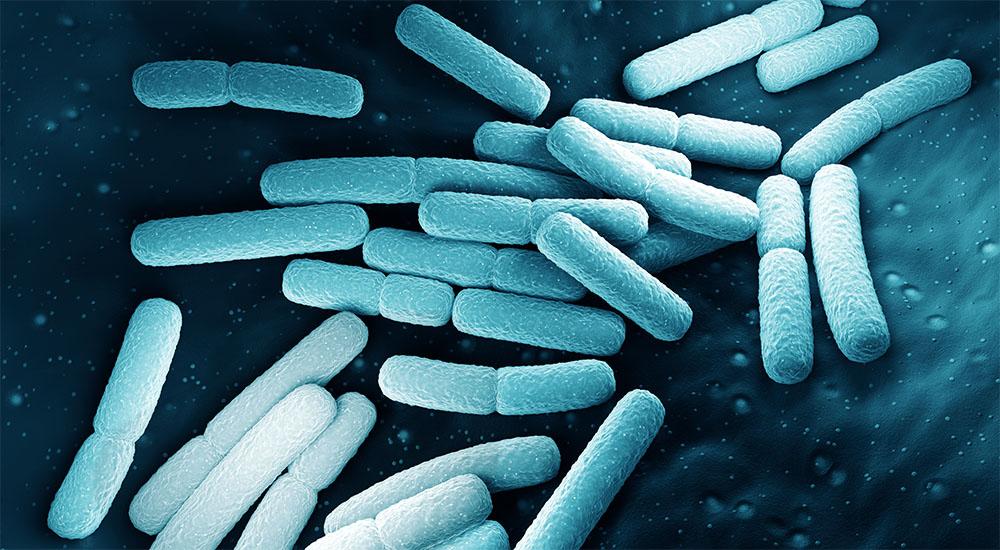Cronobacter sakazakii, formerly Enterobacter sakazakii, is a gram-negative bacterium that belongs to the Enterbacteriaceae family. It is found in the environment, commonly on plant and organic materials, and can survive very dry conditions. The bacterium has been isolated from dry foods such as powdered milk, herbal teas and powdered infant formula. Cronobacter infections are rare; however, they can be deadly for infants, especially those born prematurely.1,2 Over 90% of Cronobacter infections in infants have been linked to powdered infant formula.1
Colony Appearance:
Cronobacter colonies on sheep blood agar are medium size, circular colonies with a yellow-tan color and a glistening appearance.
Microscopic Characteristics:
Cronobacter is a gram negative, rod-shaped bacterium.1

Cronobacter sakazakii, formerly Enterobacter sakazakii, on TSB agar (Source: CDC)
Conditions for Growth:
Cronobacter is considered a facultative anaerobe known to grow at a wide range of temperatures from 5 – 44°C. Its optimal temperature range is 34 – 37°C, and it grows well on non-selective or selective media. Cronobacter has a heteropolysaccharide capsule resistant to desiccation and osmotic stresses, meaning it can survive for extended periods of time in dry environments. Cronobacter spp. are acid tolerant which makes them resistant to the low pH of the human stomach, and they can form biofilms, making them resistant to disinfectants.1
Habitat:
The natural habitat for Cronobacter spp. is primarily plant and organic material. However, it has been isolated from a variety of foods including cheese, meat, powdered milk, dry cereal and spices. Powdered infant formula is the most commonly discussed due to the high risk to infants.1
Powdered infant formula is not considered sterile. Precautions are taken to monitor the product, but producing sterile powdered infant formula is not possible through current manufacturing processes.5 The product can become contaminated from raw materials, during the production process, or at home by the consumer through contaminated water or feeding items.2
Pathogenicity:
Cronobacter infections can happen to anyone, but are most common in infants. Infections typically cause sepsis or meningitis. A meningitis infection can result in a brain abscess or other complication that can cause long-term neurological issues. Infants under two months old, those born prematurely and those with lower immune function due to illness or medical treatments are at a higher risk of Cronobacter infections. 2,3
Cronobacter, although rare, can cause infections in adults as well. The common symptoms are diarrhea and urinary tract infections. The elderly or those with compromised immune systems may experience more severe symptoms such as bloodstream or respiratory infections. 2,3,4
Environmental Risk:
Due to the adaptable nature of this organism and its resistance characteristics, it’s difficult to list specific target environments. Cronobacter could be found in both wet and dry environments. Is it necessary to test all food products for Cronobacter? Not necessarily. However, considering the risks to infants, powdered infant formula or powdered milk is a large focus when testing for Cronobacter species.
A number of steps can be taken by manufactures to detect Cronobacter in their final product:
- Educate laboratory personnel on how to identify Cronobacter morphology or use an identification system that can detect this organism
- Test raw ingredients for Cronobacter
- Test final products for the presence of Cronobacter
- Conduct environmental monitoring samples to detect Cronobacter in the manufacturing facility
It is also important that consumers take precautionary measures to prevent infections. According to the Centers for Disease Control and Prevention (CDC), several steps can be taken to prevent Cronobacter infections from powdered infant formula: 3
1. Carefully clean, sanitize and store feeding items safely, including:
- baby bottles
- other feeding items
- breast pump parts
2. Prepare powdered infant formula safely. The best way to prepare formula is to follow the steps below:
- Keep powdered formula lids and scoops clean
- Close containers of infant formula or bottled water as soon as possible
- Use warm water to at least 158 °F /70 °C and pour it into the bottle
- Carefully shake, rather than stir the bottle.
- Cool the formula to ensure it is not too hot before feeding your baby
- Use formula within two hours of preparation and throw away the unused formula
- If you do not plan to use the prepared formula right away, refrigerate it immediately and use it within 24 hours. Refrigeration slows the growth of germs and increases safety.
3. Practice proper hygiene. Always wash your hands with soap and water during the following times:
- Before preparing and feeding bottles or foods to your baby
- Before touching your baby’s mouth
- Before touching pacifiers or other things that go into your baby’s mouth
- After using the toilet or changing diapers
If soap and water are not available, use an alcohol-based hand sanitizer with at least 60% alcohol. Hand sanitizer with at least 60% alcohol is effective in killing Cronobacter.
Taxonomy
| Kingdom: | Bacteria | Order: | Enterobacteriales |
| Phylum: | Proteobacteria | Family: | Enterobacteriaceae |
| Class: | Gamma Proteobacteria | Genus: | Cronobacter |
Interested in using a Cronobacter QC strain for your testing? Microbiologics offers Cronobacter sakazakii in three easy-to-use formats.
References:
1 Cronobacter Species Contamination of Powdered Infant Formula and the Implications for Neonatal Health (2015) https://www.ncbi.nlm.nih.gov/pmc/articles/PMC4489094/
2 Cronobacter Expanded Information (2015) https://www.cdc.gov/cronobacter/technical.html
3 Learn About Cronobacter Infections (2017) https://www.cdc.gov/features/cronobacter/index.html
4CDC Warns of Cronobacter in Powdered Milk, Infant Formula (2016) http://www.foodsafetynews.com/2016/04/125714/#.WgCrMf_rvIU
5NSW Food Authority, Microbial Quality of Powdered Infant Formula (2011) http://www.foodauthority.nsw.gov.au/_Documents/scienceandtechnical/Microbiological_quality_powdered_formula.pdf






I had brain meningitis as a child, and was fed formula. I don’t know if it was caused from this bacteria, but it is a good possibility. Parents are so overwhelmed with the high demands of a baby cleanliness most likely gets overlooked especially during sleep deprived nights but is the easiest step to prevent their children from getting these kind of infections.Hopefully pediatricians stress the importance of this to parents before they take their child home!